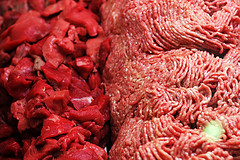Beef Company Insists Pink Slime Doesn't Exist, While Critics Say It Ain't Ground Beef
The makers of the ground beef filler we all know now as “pink slime” aren’t taking this nickname lying down. After losing business from grocery stores, Beef Products Inc. is fighting back in the media, insisting pink slime isn’t even a real thing. Opponents of the stuff are firing right back.
BPI is preparing to launch a consumer education program aimed to restore confidence in the product it calls lean finely textured beef, says ABC News, and tell people all about the meat sanitization process. Nothing says nutritious food like sanitized food. Yum.
“‘Pink slime’ doesn’t exist,” Jeff Carlson of BPI said. “‘Pink slime’ never existed in any way, shape or form. Our product is 100 percent beef in every regard, from quality to nutrition.”
They’re going to remind consumers that the USDA had approved of the meat that was in 70% of grocery store hamburger until the pink slime controversy hit, claiming it has “the same nutritional value as any 94-percent lean product that you’d find on the marketplace today.” The company has had to suspend production in three of its plants due to the fall in demand.
Meanwhile, critics of the stuff, including the man who first used the term “pink slime,” says the company shouldn’t be comparing their product to fresh ground beef, because of all the nasty things it goes through to separate meat from fat and kill bacteria.
It all starts when BPI warms the meat scraps enough so they don’t cook but can be easily separated in a centrifuge, says Gerald Zirnstein, the former USDA microbiologist and father of the phrase “pink slime.”
“At that temperature, you increase the level of pathogens and the level of spoilage bacteria,” Zirnstein told ABC News. “In order to turn this into a product they can potentially sell as ‘meat,’ and that’s, [in] quotations, ‘meat,’ they add ammonia.”
The ammonia kills pathogens, but it also keeps the meat pink — hence, pink slime, instead of the gray slime you’d see otherwise. That color-fixing keeps the public thinking it’s red meat, solely because of the color, but he says they’ve been tricked.
Another former USDA microbiologist, Carl Custer, agrees with his colleague that pink stuff that looks like meat, isn’t exactly meat.
“Microbiologically safe and nutritionally complete are two different issues,” Custer said. “It may be pink [but], nutritionally, it is not equivalent to whole-muscle tissue.”
BPI won’t label their product because it’s just innocent ground beef. Nothing to see here, move along!
BPI’s vice-president and the wife of the owner responded in her press conference Monday: “What should we label it? It’s 100 percent beef. What do you want us to label it?”
Beef Products Inc. Comeback: It’s not ‘Pink Slime’; It’s Safe, Nutritious and ‘It’s Beef’ [ABC News]
Want more consumer news? Visit our parent organization, Consumer Reports, for the latest on scams, recalls, and other consumer issues.


